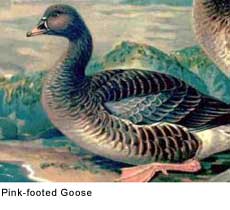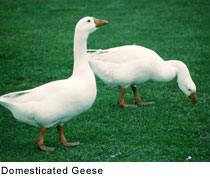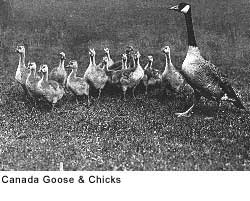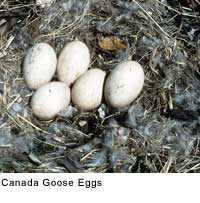|

 The Pink-footed Goose: The Pink-footed Goose (Anser brachyrhynchus) is a goose breeding in Greenland, Iceland and Svalbard. It winters in nortwest Europe, especially Great Britain. Here large flocks graze on farmland, particularly in Norfolk, The Fens, Aberdeenshire, and Lancashire. The Pink-footed Goose has the bill short, bright pink in the middle, and the feet also pink, which is diagnostic.The upper wing-coverts are nearly of the same bluish-grey as in the Greylag Goose. The Pink-footed Goose: The Pink-footed Goose (Anser brachyrhynchus) is a goose breeding in Greenland, Iceland and Svalbard. It winters in nortwest Europe, especially Great Britain. Here large flocks graze on farmland, particularly in Norfolk, The Fens, Aberdeenshire, and Lancashire. The Pink-footed Goose has the bill short, bright pink in the middle, and the feet also pink, which is diagnostic.The upper wing-coverts are nearly of the same bluish-grey as in the Greylag Goose.
The Canadian Goose: The black head and neck with white "chinstrap" distinguish this goose from all except the Barnacle Goose, but the latter has a black breast and grey, rather than brownish, body plumage. There are 7 subspecies of this bird, of varying sizes and plumage details, but all are recognizable as Canada Geese. Some are hard to distinguish from the Cackling Goose (Branta hutchinsii), with which the Canada Goose was long assumed to form one species, and the name Lesser Canada Goose is, confusingly, often applied to B. hutchinsii.
The Greylag Goose: The Greylag is a large goose, 74-84 cm long with a 149-168 cm wingspan. It has a large head and almost triangular bill. The legs are pink, and the bird is easily identified in flight by the pale leading edge to the wing.
 The Domesticated Goose: It has increased greatly in size and fecundity from its ancester, the Greylag Goose, but almost the only change in plumage is that tame geese are bred to lose the darker tints of the wild bird, and are more or less marked with white - being often wholly of that colour. From the times of the Romans, white geese have been held in great estimation, and hence, doubtless, they have been preferred as breeding stock The Domesticated Goose: It has increased greatly in size and fecundity from its ancester, the Greylag Goose, but almost the only change in plumage is that tame geese are bred to lose the darker tints of the wild bird, and are more or less marked with white - being often wholly of that colour. From the times of the Romans, white geese have been held in great estimation, and hence, doubtless, they have been preferred as breeding stock
The most generally recognized breeds of domestic geese are the Emden and Toulouse; but a single breed, said to have come from Sevastopol, was introduced into western Europe about the year 1856. In this the upper plumage is elongated, curled and spirally twisted, having their shaft transparent, and so thin that it often splits into fine filaments.
  Diet: All geese eat an exclusively vegetarian diet, and some can become pests when flocks feed on arable crops. Diet: All geese eat an exclusively vegetarian diet, and some can become pests when flocks feed on arable crops.
Goslings: Geese tend to lay a smaller number of eggs than ducks. However, both parents protect the nest and young, which usually results in a higher survival rate for the young geese, known as goslings. Because geese have proved remarkably resistant to intensive rearing methods, and they therefore remain an expensive luxury compared to other poultry, such as the chicken and
domesticated turkey.

An Old Favorite: Geese have been domesticated for centuries. In the West, farmyard geese are descended from the Greylag, but in Asia the swan goose has been farmed for at least as long.
Old Word Bird: Goose in its origins is one of the oldest words of the Indo-European languages, the modern names deriving from the proto-Indo-European root, ghans, hence Sanskrit hamsa (feminine hamsii), Latin anser, Greek khén etc.
Foie Gras: Geese produce large edible eggs, approximately four inches (100mm) from top to bottom. They can be used in cooking just as ordinary chicken's eggs, though they have proportionally more yolk, and this cooks to a slightly denser consistency. Taste is more or less the same as a chicken's egg.
Geese in fiction and myth:
When Aphrodite first came ashore she was welcomed by the Charites (Roman "Graces"), whose chariot was drawn by geese.
 There are Mother Goose tales, such as a farmwife might have told; there is the proverbial goose that laid the golden eggs, warning about the perils of greed. There are Mother Goose tales, such as a farmwife might have told; there is the proverbial goose that laid the golden eggs, warning about the perils of greed.
The geese in the temple of Juno on the Capitoline Hill were said by Livy to have saved Rome from the Gauls around 390 BC when they were disturbed in a night attack. The story may be an attempt to explain the origin of the sacred flock of geese at Rome.
There is a Christian reference (Father Augustine) to the goose that relates to the coming of the winter solstice or as it is called "The Great Freezing". One of the reasons for harsh winter seasons was to scare or cull the goose population (a creation of the devil). This cyclical process is supposed to be symbolic of the struggle between evil (Satan) and God. Evil may never be completely put down, but God shall always triumph.
One of Aesop's Fables relates the story of The Goose That Laid the Golden Eggs, the phrase itself passing into the language.
Genus Anser Brisson 1760, Grey Geese
* Greylag Goose Anser anser
* White-fronted Goose A. albifrons
* Lesser White-fronted Goose A. erythropus
* Bean Goose A. fabalis
* Pink-footed Goose A. brachyrhynchus
* Bar-headed Goose A. indicus
* Swan Goose, A. cygnoides
Genus Chen Boie 1822 or Anser (depending on authority cited), White Geese
* Snow Goose Chen caerulescens or Anser caerulescens
* Ross's Goose, C. rossii or A. rossii
* Emperor Goose, C. canagica or A. canagicus
Genus Branta Scopoli 1769, Black Geese
* Brent Goose Branta bernicla
* Barnacle Goose B. leucopsis
* Canada Goose B. canadensis
* Cackling Goose B. hutchinsii
* Red-breasted Goose B. ruficollis
* Hawaiian Goose or Ne-ne-, B. sandvicensis
* Ne-ne--nui or Woods-walking Goose, B. hylobadistes Conservation status: Prehistoric
Genus Cereopsis
* Cape Barren Goose, Cereopsis novaehollandiae
Genus Cnemiornis, New Zealand Geese Conservation status: Prehistoric
* South Island Goose, Cnemiornis calcitrans Conservation status: Prehistoric
* North Island Goose, Cnemiornis gracilis Conservation status: Prehistoric
All text is available under the terms
of the GNU Free Documentation License
|